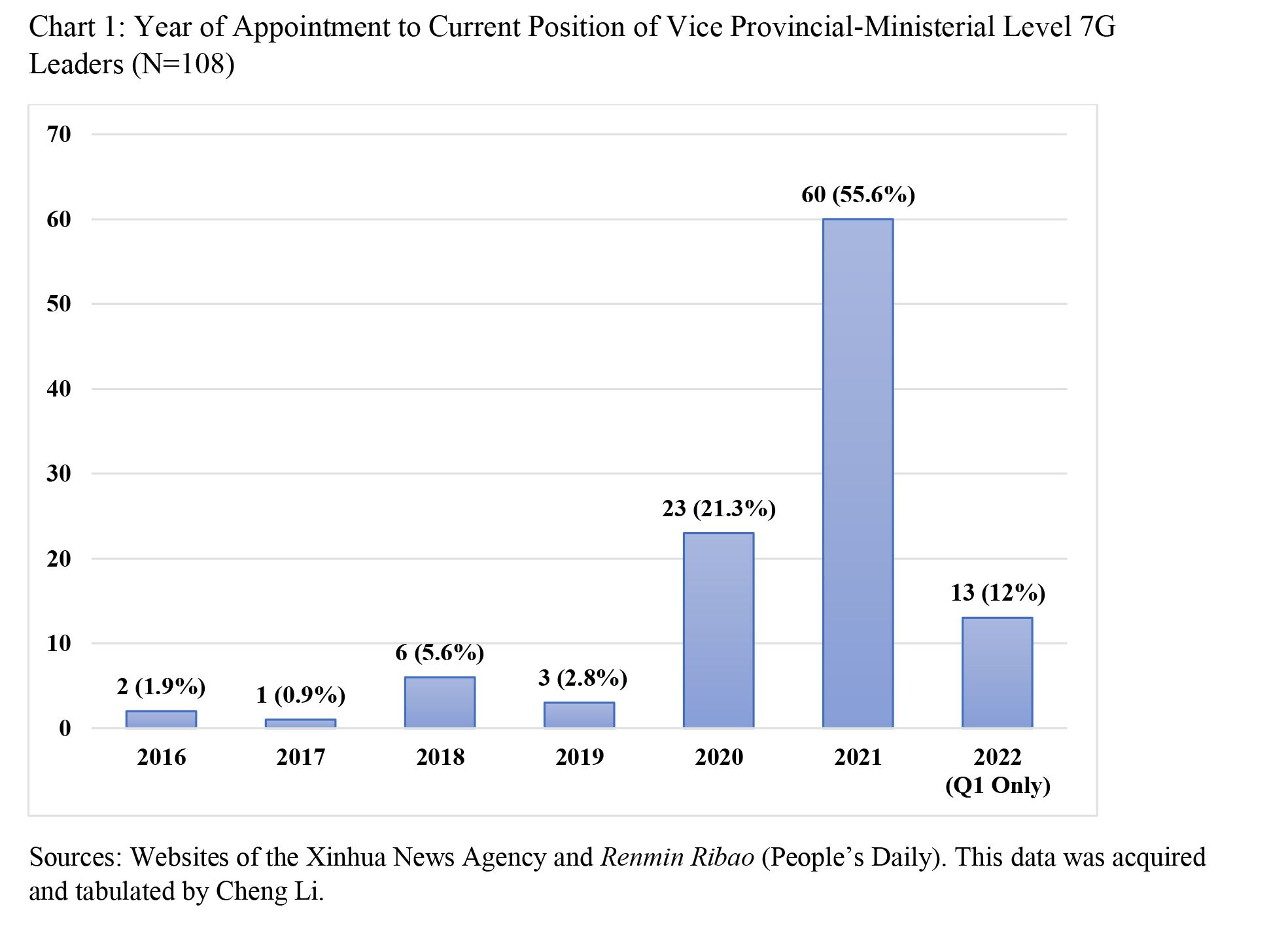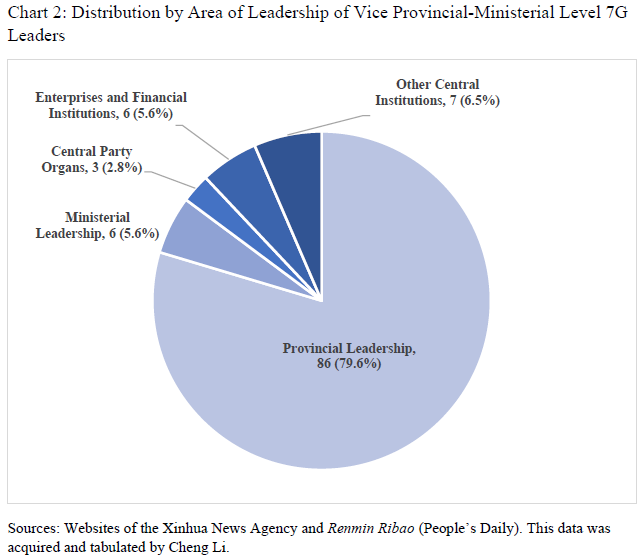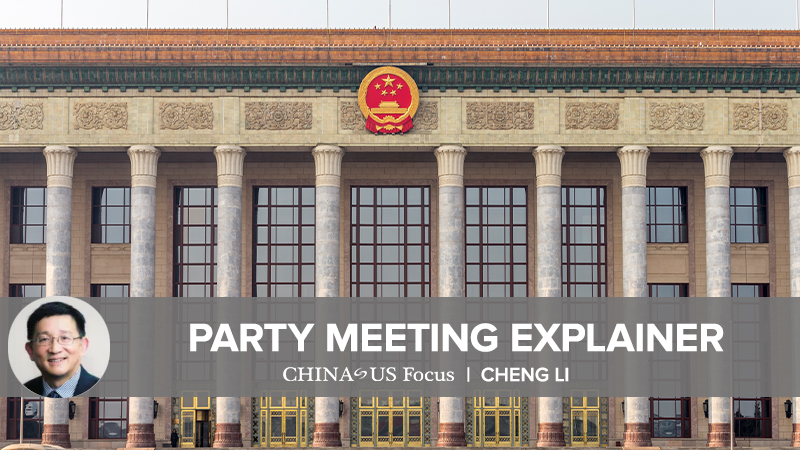It would not be an exaggeration to say that the Chinese Communist Party (CCP) has long been overly concerned about the age echelons of its political elites. For Zhongnanhai to maintain its one-party rule over the vast country, it must ensure that the political leadership will not be disrupted by the “intergenerational deletion of cadres” (ganbu qinghuang bujie).
In the early 1980s, Deng Xiaoping and other senior leaders, including Chen Yun and Hu Yaobang, proposed the concept of the “third echelon” (disan tidui). These top Chinese leaders explicitly asserted that the CCP leadership should not only designate Jiang Zemin and Li Peng to be successors to the top leaders, but also should work to groom younger officials such as Hu Jintao (who was in his late 30s then) as leaders of the successive tier to succeed Jiang and Li in the future.
The CCP’s key issue: Intergenerational continuity
Although the term “third echelon” was widely used only in the 1980s and 1990s, the practice of selecting and training the younger cluster of CCP cadres has remained prevalent over the past two decades. In December 2021, in a long article widely circulated in official Chinese propaganda outlets, Director of the CCP Central Organization Department Chen Xi stated that the “key and fundamental issue” that China confronts is whether the Party can cultivate succeeding generations of competent cadres. Chen specified that the powerful Central Organization Department will provide young cadres with richer experiences to enhance their leadership capabilities through “multi-post training” and “layer-by-layer tests.” Furthermore, Chen bluntly stated that “Cadre loyalty is the soul of the CCP’s reign.”
Understandably, if CCP authorities fail to promptly promote clusters of leaders from the younger generations to higher offices, political conflict between the different generations may arise. In July 2018, Xi Jinping stated at the CCP National Organizational Work Conference that “the enthusiasm of cadres of all ages should be brought into full play so that the entire cadre team will be motivated and hopeful.”
The previous essay in this series illustrated the predominance of the post-1960s generation (6G) in the national leadership at present –– and for at least the next decade, as well. The representation of the age echelon that follows –– the post-1970s generation (7G) –– will also rapidly increase on the 20th Central Committee (CC), which will be formed next fall. As for the current 376-member 19th CC, only two members (both with alternate status) were born in the 1970s. They are current Vice President of the Chinese Academy of Sciences Zhou Qi (1970) and current Party Secretary of Xinyang City (in Henan province) Cai Songtao (1974). The percentage of 7G leaders on the CC, however, is expected to increase from 0.5 percent on the current CC to almost 10 percent on the 20th CC.
The rapid rise of 7G leaders
At present, all of China’s 31 province-level administrations each have at least one 7G leader serving as vice governor. In Hebei province, three vice governors belong to the 7G cohort. In the ongoing reshuffling of provincial leadership, about one-third of new entrants to provincial Party standing committees were born in the 1970s.
My empirical research shows that, by the end of March 2022, there are altogether 108 civilian leaders who were born in the 1970s currently serving as vice-provincial and vice-ministerial level officials. As for the military, according to an official Chinese source, by May 2020, there were already more than 20 officers in the People’s Liberation Army (PLA) who were born in the 1970s serving at the army level (junji) with the rank of major general, which is equivalent to the vice-provincial and vice-ministerial level of the civilian leadership. For example, Major General Huo Jiangang (1970) was appointed commander of the Group 49 Army in 2019. Since 2021, he has served as the dean of the Joint Operations School of the PLA National Defense University.
This essay focuses on 7G civilian leaders at the vice-provincial and vice-ministerial level. Among these 108 high-ranking officials, 96 (89 percent) were appointed to their current positions over the past two years, and 73 leaders (more than two-thirds) have advanced to this important level of leadership since 2021 (see Chart 1). In November 2016, Liu Jie, then chief-of-staff of the Jiangxi provincial Party standing committee and now Hangzhou Party secretary, became the first 7G member of a provincial Party standing committee in the country. The number of 7G cohort members in the provincial Party standing committees increased from 13 in July 2021 to 26 in December 2021, doubling within six months.

By March 2022, the total number of 7G members of provincial Party standing committees reached 46 –– with more than half of the 7G vice-provincial level leaders holding standing committee membership. Overall, the 7G cohort now constitutes more than 11 percent of membership in the 6G-dominated provincial Party standing committees.
The CCP Central Organization Department has recently made a concerted effort to promote 7G leaders. In March 2022, Zhuge Yujie (1971) was appointed Shanghai deputy Party secretary, becoming the first 7G leader to serve as deputy secretary at the provincial level in the country. Until now, no 7G official has attained the rank of full province- or minister-level leader (zhengbuji). The other 7G rising stars include Guizhou Secretary of the Political and Legal Committee Shi Guanghui (1970), Fujian Executive Vice Governor Guo Ningning (1970), and Tibet Organization Department Director Lai Jiao (1972).
Also recently, 7G leaders have been appointed as Party secretaries of major cities, including several capital cities in important provinces. The most prominent examples are Jinan Party Secretary Liu Qiang (1971), Xiamen Party Secretary Cui Yonghui (1970), Hangzhou Party Secretary Liu Jie (1970), Wenzhou Party Secretary Liu Xiaotao (1970), Suzhou Party Secretary Cao Lubao (1971), Taiyuan Party Secretary Wei Tao (1970), Kunming Party Secretary Liu Hongjian (1973), and Urumqi Party Secretary Yang Fasen (1971). All of these leaders concurrently serve as members of the Party standing committee in their respective provinces. Given the high administrative status of these cities, the aforementioned municipal Party secretaries are all expected to become first-time members (most likely as alternates, but potentially as full members) of the 20th CC. They are among the pioneers of the upcoming elite generation that will run the country in due course.
The formative experiences and demographic traits of 7G leaders
A majority of 7G vice-provincial and vice-minister level leaders –– 103 out of 108 (95 percent) –– were born in the early 1970s. The median birth year of the group is 1971. The youngest is Ren Wei, Tibet executive vice governor and member of the provincial Party standing committee, who was born in 1976.
A recent widely circulated article in Chinese social media called those who were born in the early 1970s part of “the luckiest age cohort in the PRC.” According to the article, this age cohort had no sense of the hunger and starvation that their proceeding age cohorts experienced. This is because the country had already experienced what the Chinese authorities called “three years of natural disaster” in the early 1960s, almost a decade before they were born. They were also too young to have experienced physical hardship as “sent-down youths” who worked as farmers in rural areas as had many in the Cultural Revolution generation.
They were not part of the “single-child generation” –– those who grew up in a single-child family because of the strict family planning policy implemented in the early 1980s. They usually had grown up with siblings and thus did not suffer from the “single-child family syndrome.” Instead, they were “children of the reform era” –– the first age cohort to be born into emerging middle-class families in urban China. Their formative years saw China’s extensive integration into the global economy resulting from the country’s accession to the World Trade Organization (WTO) in 2001.
Among the 108 leaders in this age cohort, only seven (6.5 percent) are female, and four of them currently serve as members of provincial Party standing committee, including Guangxi Executive Vice Governor Cai Lixin (1971), aforementioned Fujian Executive Vice Governor Guo Ningning (1970), Hunan Vice Governor Zhang Yingchun (1970), and Liaoning United Front Director Hu Lijie (1971). They are among the leading candidates for alternate membership on the 20th CC.
Unsurprisingly, 97 of 108 of these 7G leaders (90 percent) are Han Chinese. The leaders who come from an ethnic minority background include three Manchurians, two Hui, one Mongolian, one Tibetan, one Tujia, one Zhuang, one Uyghur, and one Gelao. Some of these 7G ethnic minority leaders, for example, Chief-of-Staff of the Tibetan Party Committee Dawa Ciren (1972), Taiyuan Party Secretary Wei Tao (1970), Liaoning Vice Governor Zhang Lilin (1971), Yunnan Director of United Front Work Qiu Jiang (1972), and Member of the Xinjiang Party Standing Committee Ilzat Exmetjan (1975) will also be strong contenders for alternate membership on the 20th CC.
In terms of birthplace distribution, Liaoning, Jiangsu, and Hunan have the largest representation, with 12, 10, and nine leaders, respectively. Most of the 7G leaders in this study, 88 (81 percent), joined the CCP in the 1990s. All of these 7G leaders attended college, and 102 (94 percent) obtained graduate level degrees, of which 58 (53.7 percent) hold doctoral degrees. The colleges at which the greatest number of 7G leaders received their undergraduate education include Beijing-based Tsinghua University (8) and Renmin University (7).
More than one-third of these leaders (34.3 percent) majored in engineering as undergraduates, and 27 (25 percent) studied economics, finance, and accounting. These two fields represent the two largest academic concentrations in the 7G age cohort. A total of 17 leaders (15.7 percent) majored in humanities (languages, history, and philosophy). Twelve leaders (11.1 percent) studied politics and law. Another 12 leaders (11.1 percent) majored in the natural sciences, including mathematics and statistics.
In their official bios, 23 leaders share that they have studied abroad, either as visiting scholars or degree candidates. Most of them studied in Western countries, with the largest number (9) attending universities in the United States, followed by United Kingdom (4) and Singapore (4). For example, Jiangxi Vice Governor Ren Zhufeng (1970) spent six years (1999-2005) in the United Kingdom both working in a metal minerals company and studying for an MBA at the London Business School. He later received a doctoral degree in economics at China’s Central University of Finance and Economics. He worked at China Minmetals Corporation for 16 years as a department manager, assistant to the CEO, general manager, Party secretary, and executive board chairman before being appointed as vice governor and member of the Party standing committee in Jiangxi Province in 2021.

Chart 2 shows the distribution by areas of leadership of the vice provincial- and ministerial-level 7G leaders. Almost 80 percent serve in the provincial leadership. Those who work in ministerial leadership and enterprise and financial institutions each constitute only 5.6 percent. Only a few vice ministers of China’s 27 ministries are from the 7G cohort, including Vice Minister of Finance Zhu Zhongming (1972) and Vice Minister of the National Development and Reform Commission Cong Liang (1971). The cluster of the central Party organs has the lowest representation (2.8 percent). The cluster of other central institutions (e.g., leaders of the Chinese Communist Youth League, the Chinese Academy of Sciences, and the Xinhua News Agency) constitutes 6.5 percent.
This distribution reaffirms the long-standing trend of provincial leadership serving as the key stepping stone to the CCP national leadership. But a closer look at the career patterns of these 7G rising stars reveals that many of them have had broader leadership experience in China’s flagship enterprises or major financial institutions. Furthermore, in the Xi era, elite recruitment and promotion have been more frequently based on cross-region, cross-sector, and cross-government/enterprise experience. This important phenomenon, which will be the topic of the next essay in this series, deserves greater attention.

